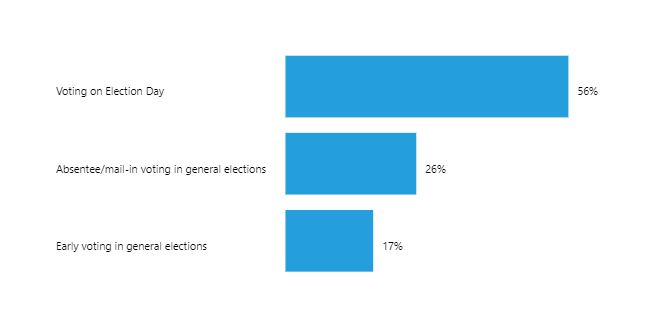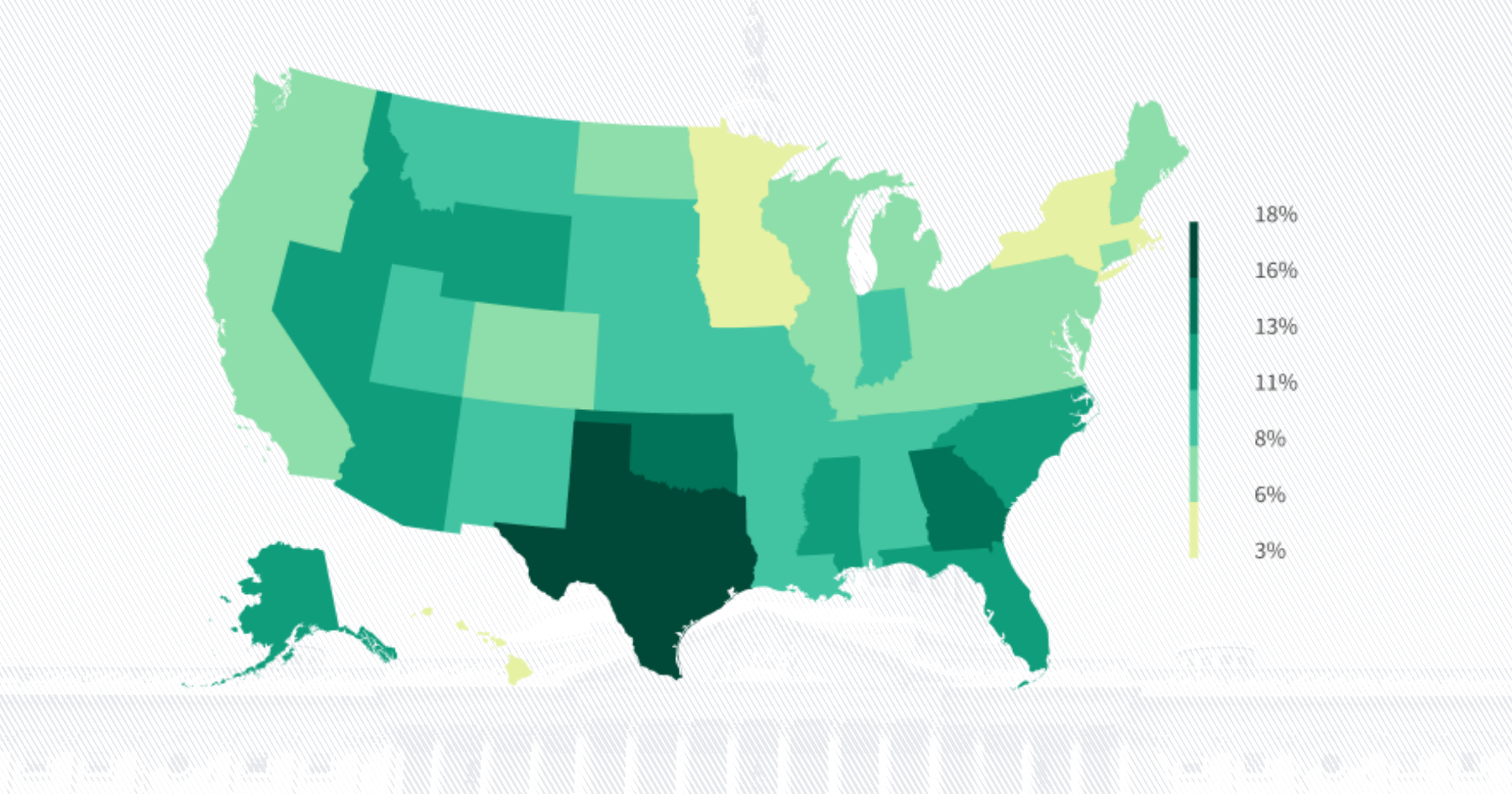Government
How does voter turnout in the US change by state, age and race?

The 2020 Democratic and Republican National Conventions have now concluded and each party has formally selected its candidate for president of the United States. Former Vice President Joe Biden accepted the Democratic nomination for president on August 20, delivering his acceptance speech from his home state of Delaware. President Donald Trump accepted the Republican nomination on August 27 in a speech delivered from the White House lawn.
National convention acceptance speeches offer insight into each candidate’s view of the major issues facing Americans. Here are five key issues touched on by both Biden and Trump, along with a look at the most recent data on those topics.
Both President Trump and former Vice President Biden spoke about COVID-19 and their plans to handle the ongoing pandemic. Trump spoke of measures already taken by his administration—like invoking the Defense Production Act to produce masks and ventilators—and claimed that America will “have a safe and effective vaccine this year.” Biden emphasized his day-one plan to tackle the virus, including to “develop and deploy rapid tests,” “make medical supplies and protective equipment,” and “have a national mandate to wear a mask.”
The US currently confirms about 41,000 new coronavirus cases and 1,000 deaths each day, according to seven-day national averages. New daily cases have fallen from their peak of 66,000 in mid-July, while deaths have hovered near 1,000 throughout August.
Find more detailed information about the spread of the coronavirus in the COVID-19 dashboard, and see metrics on health, economic recovery, and household and government spending in the COVID-19 Impact and Recovery Hub.
The COVID-19 pandemic has caused the national unemployment rate to hit double digits; both candidates shared their visions for job creation and economic recovery. Biden claimed that he would create jobs by investing in new infrastructure and clean energy operations and would add “5 million new manufacturing and technology jobs.” Trump also spoke of adding manufacturing jobs and claimed that his administration would create “10 million jobs in the next 10 months.”
The unemployment rate has declined steadily from its 2009 peak of 10% during the Great Recession. This halted in April, when the unemployment rate jumped up to 14.7%. As of July 2020, the unemployment rate was 10.2%, slightly above the Great Recession.
Find data on employment broken down by state and industry in the employment dashboard, and track other measures of economic recovery with the COVID-19 Impact and Recovery Hub.
Trump’s hardline stance on immigration was key to his 2016 campaign. In this year’s acceptance speech, he claimed he would ban sanctuary cities, continue building a wall on the US-Mexico border, and enforce “strong borders.” Biden stated that he would pursue “an immigration system that powers our economy and reflects our values."
In 2018, immigration officials removed 337,000 people from the US. This is lower than the 2013 peak of 433,000 removals, but higher than any year before 2007.
Between 2016 and 2018, the number of green cards granted decreased by about 7% from 1.18 million to 1.10 million, while naturalizations remained about the same. Asylum claims granted nearly doubled over the same time, while refugee arrivals fell 74% to 22,400, the lowest number since 1980.
For a deeper dive on immigration, start with the summary from the 2020 State of the Union report or explore all of the immigration data available through USAFacts.
Both candidates noted their stances on tax reform and referenced the 2017 Tax Cuts and Jobs Act (TCJA) passed under President Trump. Biden criticized the legislation, calling it lenient toward the “wealthiest 1 percent and the biggest, most profitable corporations.” Trump said his administration would “cut taxes even further.”
| Under prior law (2017) | Under TCJA (2018) | ||
|---|---|---|---|
| Taxable income | Rate | Taxable income | Rate |
| $0 to $9,325 | 10% | $0 to $9,525 | 10% |
| $9,325 to $37,950 | 15% | $9,525 to $38,700 | 12% |
| $37,950 to $91,900 | 25% | $38,700 to $82,500 | 22% |
| $91,900 to $191,650 | 28% | $82,500 to $157,500 | 24% |
| $191,650 to $416,700 | 33% | $157,500 to $200,000 | 32% |
| $416,700 to $418,400 | 35% | $200,000 to $500,000 | 35% |
| $418,400 and above | 39.6% | $500,000 and above | 37% |
| Under prior law (2017) | Under TCJA (2018) | ||
|---|---|---|---|
| Taxable income | Rate | Taxable income | Rate |
| $0 to $18,650 | 10% | $0 to $19,050 | 10% |
| $18,650 to $75,900 | 15% | $19,050 to $77,400 | 12% |
| $75,900 to $153,100 | 25% | $77,400 to $165,000 | 22% |
| $153,100 to $233,350 | 28% | $165,000 to $315,000 | 24% |
| $233,350 to $416,700 | 33% | $315,000 to $400,000 | 32% |
| $416,700 to $470,700 | 35% | $400,000 to $600,000 | 35% |
| $470,700 and above | 39.6% | $600,000 and above | 37% |
The TCJA altered the tax code in ways that affected both individuals and businesses beginning with the 2018 tax year. Among its many measures, the TCJA lowered the tax rate for most income brackets, removed the personal exemption, increased the standard deduction, doubled the child tax credit, and limited or discontinued certain itemized deductions. It also eliminated the Affordable Care Act individual mandate, reduced the number of estates and gifts subjected to taxation, and converted the corporate tax rate from a bracketed system to a flat rate of 21%.
Dive further into the data on taxes in the US, or see how money flows in and out of government with data on the US budget in the 2020 State of the Union report.
Both candidates addressed the topic of healthcare amid the ongoing pandemic. Trump spoke of lowering the cost of prescription drugs and health insurance premiums and said his administration would “strongly protect patients with pre-existing conditions.” Biden criticized Trump’s treatment of the Affordable Care Act and spoke about prioritizing a “health care system that lowers premiums, deductibles, and drug prices by building on the Affordable Care Act.”
In 2018, 8.5% of Americans had no form of health insurance, up from a low of 7.9% in 2017.
Health insurance spending varies by program, with higher average spending per Medicare or Medicaid enrollee as compared to those insured privately or through the Childhood Health Insurance Program.
Explore more data on healthcare in the US or learn more in the 2020 State of the Union report.
In their nomination acceptance speeches, presidential candidates Joe Biden and Donald Trump spoke about many of the same issues facing America today including COVID-19, jobs and unemployment, immigration, taxes, and healthcare. While their policy proposals may differ, both candidates and the American people can use government data to understand how the country is doing and to measure future progress.
Learn more from USAFacts and get the data directly in your inbox by signing up for our newsletter.
Government
Government
Government
Government
Newsletter
Keep up with the latest data and most popular content.


